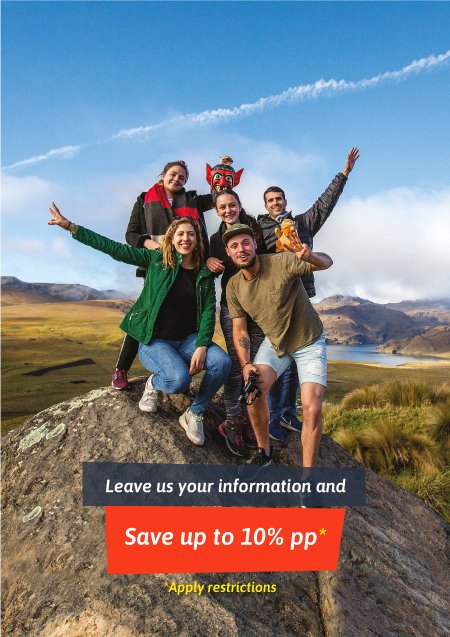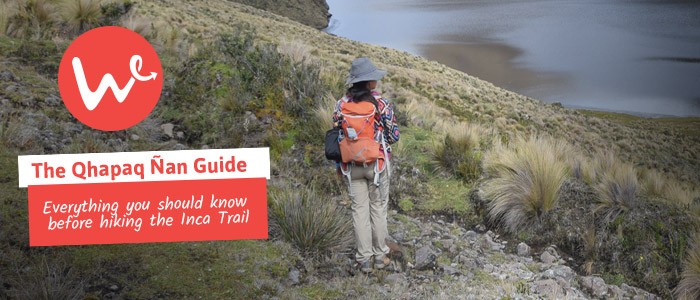Inca Trail in Ecuador
Discover The Qhapaq Ñan
Inca Trail in Ecuador: The Qhapaq Ñan
The Inca Trail also known as Qhapaq Ñan is a network of roads that spread among 6 countries in South America: Argentina, Chile, Bolivia, Peru, Ecuador, and Colombia. The Qhapaq Ñan roads were used by the Incas to control their empire. This Inca Trail was connected by several roads and routes that lead to Cusco, the capital of the Inca Empire, facilitating the integration and communication among its people.
The Inca Empire had a group of people called “Chasquis.” These Chasquis were messengers that move along the Qhapaq Ñan from city to city carrying important news and messages. For secrecy purposes, the messages were sent through a code of knots in a rope. According to some studies, it took 10 days for a message to arrive from Quito to Cusco.
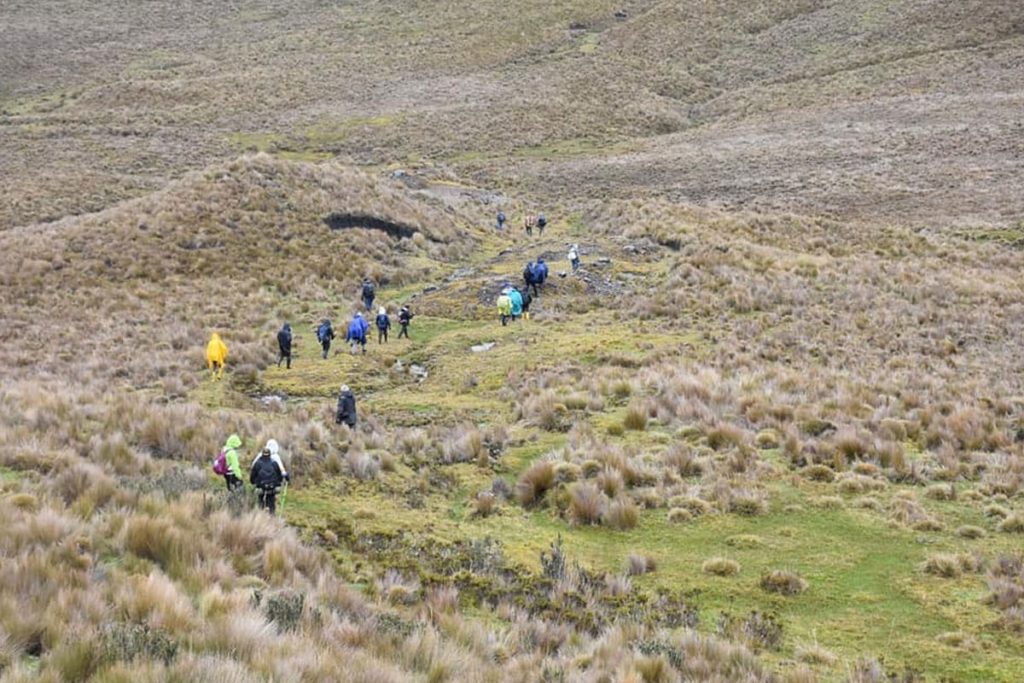
Qhapaq Ñan: The Trails
The Inca Trail in Ecuador stands out for its roads and construction techniques. The Qhapaq Ñan possess an important architectural and social value, which represents the lifestyle of the indigenous people that lived in the Inca Empire many centuries ago.
There is a fragment of the Qhapaq Ñan that crosses the Sangay National Park, in the Cañar Province, and it is considered the most well-preserved section in Ecuador. The trail extends for 30 km in the southern part of the Sangay National park, from the town of Achupallas, to the Ingapirca Archaeological Complex.
You can make your trekking journey from Culebrillas lagoon to Ingapirca Ruins in approximately 6 hours.
The Inca Trail was declared a World Heritage Site by Unesco, which has allowed the development of sustainable tourism activities among its nearest communities.
Coyoctor: Baños del Inca
Coyoctor is an archeological site located just 1 km away from Ingapirca, and strategically situated and lined with Yanacuri hill. You cannot miss visiting Coyoctor after exploring Ingapirca. Studies suggest that due to its closeness, both sites were part of the same ceremonial and administrative complex. This historical site is made up of a big court, an Inca chair, the Cañari Altar, and the Inca´s baths. While walking around you would be able to observe 2 water reservoirs, which stand out, for water storage that comes from the sacred hill Yanacuri. This water was used for ceremonial purposes.
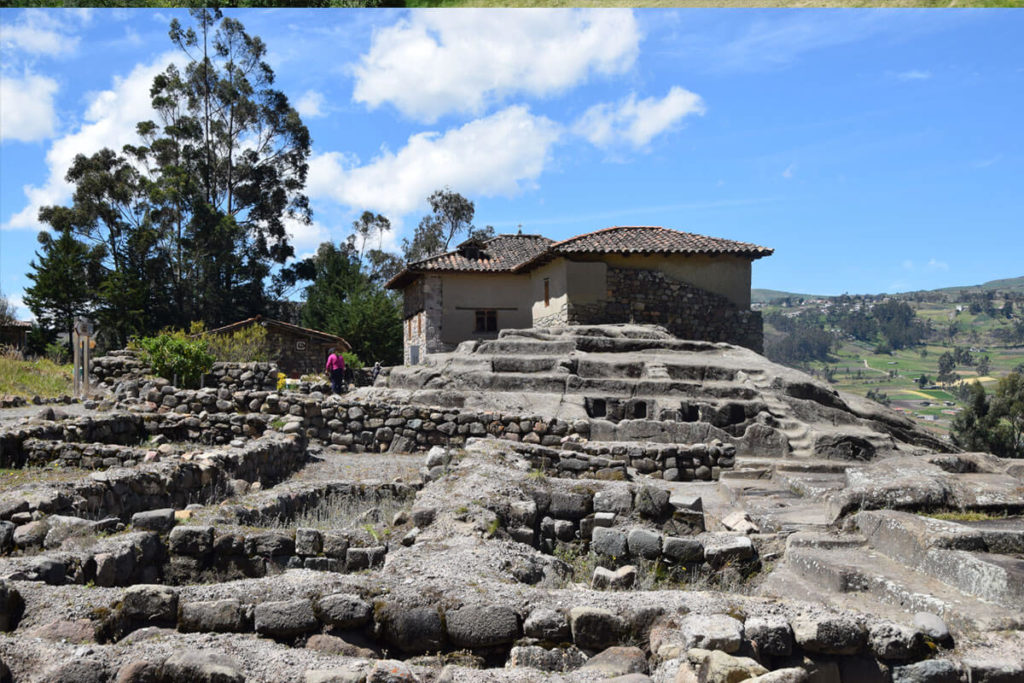
Cojitambo
Located 21 km outside the city of Cuenca, Cojitambo is an Inca archeological complex. These ruins are much smaller than Ingapirca but of considerable importance. Composed of the Quichua word ‘Curi,’ which means gold, and ‘Tampu’ or ‘Tambo’ which means deposit or resting place. Legend says Cojitambo is one of many different sites alleged to contain part of the gold ransom that was supposed to be delivered to the Spaniards for the release of Atahualpa, the last Inca Emperor. The historical Cojitambo complex has several stone structures built by the Incas in a natural terrace where bits and pieces of embankments, housing structures, and walls are still clearly visible. There is also a plaza where rituals, sacrifices, and offerings were given to the Gods.
Pillcomarca
It is a community located in the town of Cojitambo. It offers guided tours to the archaeological site and the alternative of experienced-based tourism. While enjoying the experienced-based tourism visitors can share traditions with the local people, and spend the night in community accommodation or camping under the stars. You will find the largest climbing wall in Ecuador with more than 180 routes with heights up to 200 meters high.
Sisid Anejo
Sisid Anejo was considered a resting area on the Inca Trail. Now it is one of the oldest and largest communities in Ecuador. It is located a few minutes away from Ingapirca. The community territory covers an area larger than 4500 acres where you can find the Culebrillas lagoon and the archaeological sites of Paredones, Labrsacarumi, and the Inca Trail. Nowadays the community is dedicated mainly to tourism.
Sisid Anejo can provide accommodation with a private bathroom, hot water, and internet. Also, the community offers guiding services through its local people. You can visit the patrimonial chapel, which is more than 350 years old and is the second oldest chapel in Ecuador.
Launag Grande
Launag Grande is a beautiful community located in a strategic place in the south Chimborazo´s moors, surrounded by magnificent landscapes, waterfalls, grasslands, rivers and trails among rock walls. The community offers lodging accommodations from $50 that include a local guide tour and the experience of sharing daily life routines with the indigenous local people.
One of the best attractions offered by this community is the guided horseback riding tours through the Inca Trail. The riding service is offered from the communal house to the Culebrillas lagoon. This is a different way to experience the Qhapaq Ñan.
Comuna de Azuay
Enjoy the cultural and ancestral heritage in the hands of the Comuna de Azuay with packages adapted to the needs of all travelers. The community offers many hiking tours through Cahiloma Gazatuz, Pampa llihuinag, Guncan, Pucara Loma, and more. It also offers guided horseback riding in the magnificent Andean moors. Another interesting offer for visitors are the cultural presentations, traditional games, and typical food.
Caguanapamba
This community is located only 5 km away from the archeological ruins of Ingapirca and since 2008 Caguanapamba is at the top of the list leading the communal tourism in the region. This community has continued to work on diverse development plans and programs; as well as providing unforgettable adventures and life experience tourism. This last one was incorporated into the community with the purpose of sharing indigenous everyday life with visitors.
Among the many offered activities, the ones that stand out are the healing rituals of local´s priests or yachaks, and the indigenous trials and judgment. Also guests can experience planting and harvesting orchards, shelling corn, knowledge of ancestral medicine plants, shear alpacas, and many other activities uncommon to the city life. Every visitor that sets foot on this lovely community will cherish every moment and experience close to his heart; and undoubtedly will want to visit again.
Achupallas
A cute little parish, located at 3000 meters in the Andes. This magical place is surrounded by moist moors where rivers and creeks are born. This abundant water bathes its fertile lands, allowing a rich and multi-colored landscape. In addition, it has natural lagoons which offer the most beautiful settings in the highlands. This was considered a very important and strategical place in the Tahuantinsuyo, given that here was an important reserve of agricultural products that later were distributed to other equally important places. This little piece of heaven, located in Alausi, is currently made up of 23 communities. Visitors will remain speechless when they acknowledge the peace this place conveys, always leaving them wanting for more!
Culebrillas Lagoon
Hidden among grasslands and covered by a mystical fog is the Culebrillas Lagoon. Consider a mythical and sacred place for the Incas because of its snake shape; the lagoon was an important element that connected Quito with Cuzco. Nowadays, it is one of the most visited places by adventurers daring to undertake the most famous trekking in Ecuador, the Inca trail. Located at the base of the Yanahurco hill or commonly known as Black Hill, in the Cañar province, it presents natural and archeological attractions such as the Tambo of Paredones. In Quichua Tambo means resting place. From north to south, a 2-day walk from Achupallas, can be done, to the lagoon. Another option is getting there by car, from the communities of Sisid Anejo or Caguanapamba.
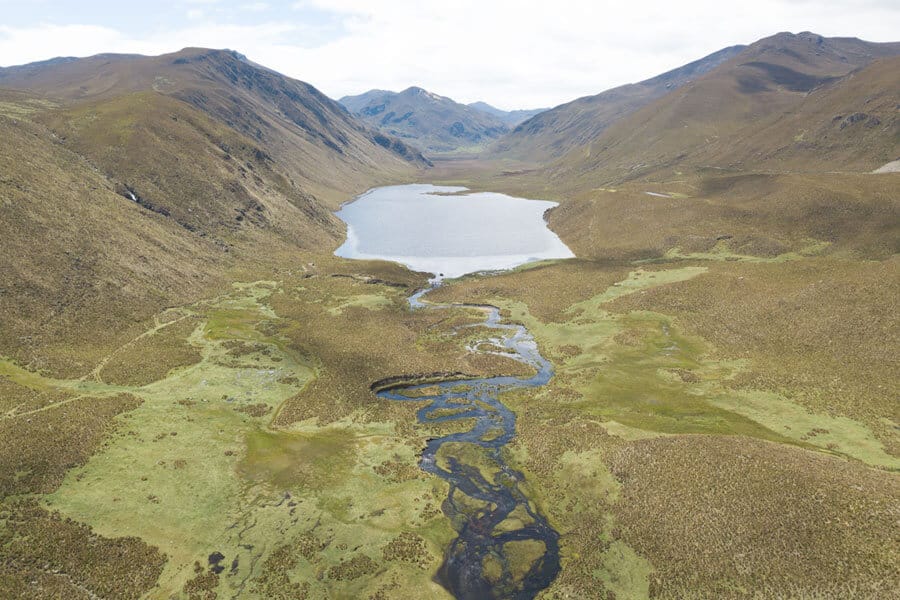
Tres Cruces
Inside the National Park Sangay, after a 5-hour walk from the town of Achupallas, is located the fascinating Tres Cruces Lagoon. A milestone in the Qhapaq Ñan route as it establishes the perfect place to set up camp and spend the night. The piercing cold of the place will not be a hassle for the adventurers, once they admire the beautiful scenery from the comfort of their tents sipping hot tea. At sunrise, the lagoon presents an exceptional setting. It is a magical spectacle when the first sun rays touch its icy waters while reflecting the vibrant blue sky. This delightful and colorful display invites all hikers to pack their backs and continue their masterful journey.
Essential Information
History
The Inca Trail in Ecuador is only a small section of a far greater network from which we only know a small part. An extensive Inca system of a trail of more than 23000 kilometers that joined the Inca Empire from Colombia, Brazil, Ecuador, Peru and Bolivia, some parts of Chile and Argentina.
Health and Safety
Before traveling to Ecuador, it is strongly recommended you purchase travel insurance in case of any emergency, including health and loss of possessions. If you’re planning to trek de Inca Trail, consider the adrenaline sports you might be doing and whether the insurance you purchase will cover related to these.
In the case of an emergency, you can reach an ambulance by dialing 911 or 102 (Quito Fire Department), 131 (Red Cross) or 101 (Police).
Costs to consider before doing the Inca Trail
Packages from $60 per person per day including meals and camping equipment.
Money
Always try to plan ahead so that you don’t need to visit the ATM very often, increasing chances of being targeted by thieves, and always avoid taking cash out in the evening. While trekking the Inca Trail, no ATM’s will be available.
Wifi Access
Limited Access. Wifi can be accessed in the community towns only.
Activities on the Inca Trail
- Trekking on trails
- Medium and high difficulty climbing
- Horseback riding through the mountains
- Volcano climbing
- Visit the Inca Ruins of Ingapirca
- Visit the Pailón del Diablo
Top tip: Do the 3 Day Trekking
Achieving the Inca Trail trekking usually takes 3 days, walking between 5 and 6 hours a day. The route from Achupallas to Ingapirca is about 45 km, but at an altitude of more than 3000 meters, you will not walk as fast as you would.
- Day 1: Achupallas to Tres Cruces
- Day 2: Tres Cruces to Paredones
- Day 3: Paredones to Ingapirca
Where to sleep on the Inca Trail
Ingapirca offers a few lodging options close to the ruins. The most popular one is Posada Ingapirca which is located right next to the historical site. Also, there are a few communal accommodations close to the complex where you can experience community tourism and share with the local people. Caguanapamba and Sisid Anejo are two communities which offer comfortable lodging options in their beautiful community house. Take the chance to stay in a different but hospitable place. Also, community houses offer traditional indigenous meals like the Pampamesa. Venture yourself trying this traditional and delicious dish.
What to eat
If you are looking for something really authentic, you should try the cuy (guinea pig). In fact, this is probably the best spot in the country to taste this Ecuadorian dish.
What about the weather
It is generally cold and windy. Remember that the Inca Trail is above 2500 meters above sea level. In Ecuador, there are two well-defined seasons, the dry summer season and the rainy season. The best time to do the Inca Trail is from April to October (summer season), the months from November to March, is the rainy season, which makes access and camping difficult.
Get ready for the Inca Trail
To do the Inca Trail, your heart and muscles must be strong, in order to resist and use less oxygen to avoid altitude sickness. We recommend packing:
- Backpack with straps to distribute the weight and to store enough water and clothes
- Walking shoes and socks
- Layers of clothing, including thermal clothing
- Raincoats: jacket and pants
- Walking sticks
- Hat
- High SPF sun protection
- Sunglasses
- Gloves
- Flashlights
- Toilet paper and wet towels
- Snacks
Optional:Sleeping bags
Do I need a guide?
There is no cell coverage to guide you with maps of the phones. We recommend doing the Inca Trail with local guides from the communities.
How to get to the Inca Trail
From Quito
As one of Ecuador’s major cities, you’ll find numerous modes of transport to get you there.
Public transportation: If you’re traveling by bus, you’ll need to leave from Quitumbe (“Terminal terrestre Quitumbe”) to get from Quito to Cuenca. If you’re staying in Quito’s historic center or Mariscal district, Quitumbe is a $10-20 taxi ride (depending on the time of day) or a $0.25 trip on the Trole. However, try to avoid taking the Trole by night and always keep an eye on your possessions when you’re using public transport in and around Quito.
Once in Quitumbe, you’ll find a number of bus companies that depart to Riobamba. The trip from Quito to Riobamba takes about 8 hours and costs around $10. Since it may be a long ride, select a bus company that appears to have comfortable seats!
Wanderbus Ecuador: For a trip as long as the Quito to Cuenca route, an excellent alternative to public transportation is the Wanderbus.
A number of our Wanderbus passes take you from Quito to Cuenca or Riobamba, stopping at a few must-see destinations like Cotopaxi, Quilotoa, Baños and Riobamba. If your travel plans aren’t set in stone, you should seriously consider this option. This way, the long hour journey will be broken up into more manageable chunks, giving you the chance to see the best of the Ecuadorian Andes and completely skip the inconvenience and discomfort of traveling on regular buses.
From Cuenca or Guayaquil
From Cuenca, you can either arrange a package tour, drive yourself, or take public transportation. For those wanting to take the bus, the best option is to take the 9:00am bus from the bus station OR “Terminal Terrestre”. This bus goes all the way to the historic site, waits 2 hours, and returns to the bus station in Cuenca. The only setback with this bus is that it stops every few kilometers to pick up local passengers and the ride becomes longer than it should be.
From Guayaquil the easiest way is to take a bus to Cuenca. In Cuenca you will arrive at Terminal Terrestre, and here you can switch buses to the Ingapirca bus that takes you directly to the ruins and will bring you back to the terminal.
